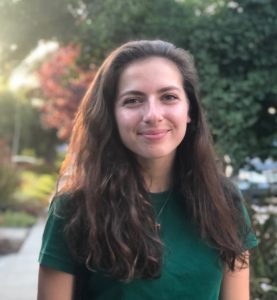Eleanor Naiman is a rising senior at Swarthmore College majoring in History. This past summer, Eleanor worked with historian Amanda Tewes of the Oral History Center on the Bay Area Women in Politics Oral History Project. As an intern, Eleanor researched the contributions of women to Bay Area politics and assisted Tewes with her interviews. Here, Eleanor reflects on her internship experience in the Oral History Center.

Eleanor Naiman, 2019
There is a science to professional oral history. From start to finish, the interview process requires meticulous attention to detail and respect for technique, form, and skill. When an OHC historian sets off to conduct an interview, be it a conversation with a Bay Area political consultant or with a Connecticut anthropologist, she does so equipped with heavy black bags of tools and folders and parts that, to the untrained (read: intern) eye, might seem better suited for the high-tech activities of a secret agent than the practice of oral history. And yet, each cord, mic, form, and gadget plays an integral role in the interview process.
Over the course of my summer as an intern at the OHC, I’ve become better versed in this highly technical science of capturing a story. I’ve learned how to identify a potential narrator and with which forms to ask for her consent. I’ve spent long hours researching the entirety of her life, creating an outline of its twists and turns and of the people with whom it has come into contact. I’ve become a convert to the practice of the “pre-interview,” a conversation that allows the interviewer to check her facts and flesh out her timeline.
Even the intimidating black tool bags have become familiar. I’ve learned to unfold a tripod to just the right height. To angle a camera towards my narrator’s left cheek, framing her head from hair to collarbone and obscuring her lapel microphone. I know how to initialize an SD card; how to stop recording, then press power; and how to make the light in the room warmer or cooler based on the narrator’s proximity to a window. My technical skills are far from perfect, and it often takes me about five times longer to set up equipment than it should, but my fumbles and mistakes only reinforce my newfound appreciation for the complex science of oral history.
And yet, if oral history is a science, it is also an art.
I have learned that oral history, at its root, relies not on the positioning of the camera or the placement of the mic but on the strength of the trust carefully built by both historian and narrator during weeks of exchanges and phone calls preceding the interview itself. This trust is not quantifiable; a relationship, it turns out, is harder to assemble than a camera tripod.
I have learned how to speak my narrator’s language, repeating the terminology she’s used to reinforce her sense of ownership of her life stories. I know to follow the flow of her memories, asking open-ended questions that evoke the feelings she experienced in a time or place. I try to understand how my own biases inform my questions, and to consider how intersubjectivity influences the relationship my narrator and I can build. I have learned to listen more deeply than I ever have. Perhaps most importantly, I know to allow my narrator to guide our conversation as an equal partner in this history we’re creating together.
This summer I have become a techie and a philosopher, a stickler for spreadsheets and a careful listener, a more confident camerawoman and a historian never so acutely aware of all that she does not know. In short, I have become a scientist and an artist: an oral historian.